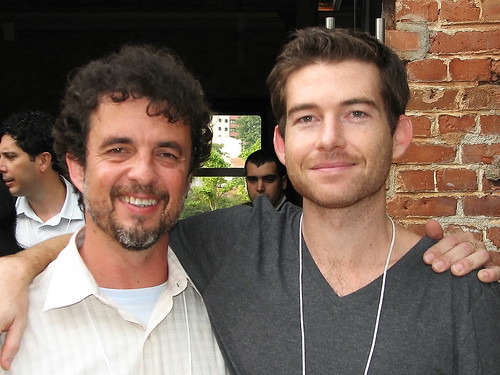What do ministers of culture do? This was the question asked by Slate political reporter Chris Beam back in 2007 when, in the same week, commandos raided the Iraqi culture minister’s house to arrest him for a 2005 assassination attempt on a fellow politician. Beam’s general conclusion: “They oversee grants for the arts, fund public broadcasting, support museums, and generally seek to preserve and promote national identity.” He also notes (citing the culture ministries of Britain, Canada, Japan, France, and Brazil) that the specific responsibilities of each ministry can vary widely.
Europeans like to poke fun at the United States for not having a minister of culture. When one European asked Yahoo! Answers “why there is no Ministry of Culture in the USA,” among the answers:
What culture? Gun carrying, money loving, whilst education and art loathing? That is the culture promoted by the Media in the USA. It’s not worth wasting money on building a ministry to represent that.
Because there is no culture in US 
Our minister of Culture is named Michael Savage.
But there are also some worthwhile explanations:
Because we are not a censored or closed society. Americas is too diverse to be represented by one person.
The government is not allowed to manipluate our culture, our culture is supposed to manipulate the government.
In fact, Beam tells us, there have been several attempts throughout the brief history of the United States to form some equivalent of a ministry of culture:
In 1859, President James Buchanan appointed a National Arts Commission, but it disbanded after two years. Teddy Roosevelt made a similar attempt 50 years later, and in 1937, during a fit of New Deal-fueled government expansion, a New York congressman introduced legislation to create a Department of Science, Art, and Literature, but the proposal never got beyond committee. Subsequent efforts to create a centralized cultural agency were hampered at least in part by negative associations with Nazi propaganda and “cultural planning” in the USSR.
********
André Malraux, an eccentric French high society novelist who was arrested in his early 20’s for attempting to remove bas-reliefs from a temple he discovered in the Cambodian jungle is commonly cited as the world’s first minister of culture, serving under Charles de Gaulle beginning in 1959. Writes Beam: he “pushed for what he called the ‘democratization of culture’ – making the arts available to everyone, not just the elite.”
Ministries of culture quickly spread throughout the world as a way for federal governments to promote national identity. This was especially important in post-colonial countries. As time went on they increasingly focused their efforts less on democratizing culture, however, and more on promoting just a few cultural superstars to attract international attention and compete on the stage of cultural globalization.
A notable and welcome exception to this trend is Gilberto Gil, a key figure in the Música Popular Brasileira and Tropicalismo movements of the 1960s, who served as Brazil’s Minister of Culture from 2003 to 2008 under Lula da Silva. Gil’s political philosophy of Tropicalismo was a natural fit to the emerging Free Culture movement of the internet generation; both celebrate a culture of remix, collaboration, and globalism. During his five years in office Gil redefined the role of the ministry of culture. Rather than perpetuating cultural pedigree, Gil hired self-declared hippie and former music producer Claudio Padro as his “digital policy coordinator” and started the Cultural Hotspots program to encourage cultural production using open-source tools in over 600 communities across the country. “We are not here to compete, we are here to share,” was a defining slogan of Gil’s mission and perspective.
My good friend Jose Murilo has been involved in several of these projects from the outset. Here he is with a youth theater group in Varjão do Torto, a low income community on the outskirts of Brasília, Brazil’s capital:

Today Jose Murilo is the Digital Culture Coordinator at the Brazilian Ministry of Culture and he has been largely responsible for creating the Brazilian Digital Culture Forum as a way to open up the ministry’s policy formulation to all Brazilians who wish to participate. Here he is describing the process at the recent Free Culture Forum in Barcelona:

Over the past few months I have been researching how governments use digital media tools to encourage more civic engagement, and how citizens use digital media tools to hold their governments accountable. What I have found, like Anil Dash, is that many governments are doing a pretty good job using digital media to spread awareness about their own initiatives, but not a very good job at taking advantage of digital media to listen to the valuable contributions that citizens can add to make better policy. There are some exceptions. (Check out Tiago Peixoto’s map of participatory budgeting projects.) For example, the FCC has implemented an Ideascale site to solicit ideas for their upcoming National Broadband Plan. But so far the leading idea has only received 221 votes and 7 comments. Out of a country of more than 300 million people.
Jose Murilo has realized that you must go beyond just putting up a website if you want to really foster more civic engagement in national policy creation. And so, in addition to the Cultura Digital platform (the best implementation of BuddyPress that I have seen), the Ministry of Culture has also been inviting diverse players in Brazil’s digital culture community to live events to offer their feedback on the ministry’s goals, activities, and strategies.
I was invited to present at last week’s Digital Culture Forum at the beautiful Cinemateca Braseilera. (Maybe the best conference venue I’ve seen.) I was impressed by the level of engagement of everyone present. While there was a lot of enthusiasm for the ministry’s initiative, it was clear that no one was going to let them get off the hook without answering tough questions. It was also clear that the Ministry of Culture is still limited in its ability to effect wider change regarding the use of open source software and open formats in government offices.
It was one of those weeks that made me proud to be involved in this whole community/movement/shared vision … whatever you want to call it. The word “utopianism” has been frequently applied of late to those of us working on projects that use digital media to promote participation and civic engagement. It’s an easy criticism to make for those who don’t like to get involved.

Jose Murilo and I in 2006

Jose Murilo and I in 2009
Murilo and I first met in person three and a half years ago at the first iCommons Summit in Rio de Janeiro. This is before Rising Voices got its start and before the Ministry of Culture even had a ‘digital culture coordinator.” Three and a half years is such a short amount of time and yet it is hard to keep track of all that has happened since our enthusiastic talks while driving through Rio’s concrete jungle about digital ecology.
I can’t wait to see what happens over the next three and a half years.





















